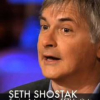Seth Shostak

Seth Shostak
Seth Shostakis an American astronomer, currently Senior Astronomer and Director, Center for SETI Research...
NationalityAmerican
ProfessionScientist
CountryUnited States of America
came kid pick
'E.T.' was far-fetched. 'E.T.' was this wimpy-looking kid that came to Earth to pick some plants, but he came from the Andromeda Galaxy to do that.
almost dinosaurs interested kids might science
I think a lot of kids are interested in two science subjects: dinosaurs and aliens. The reason is almost genetic; we're hard-wired to be interested in things that might be a little dangerous.
afternoon century expert facts field result science
Look, science is hard, it has a reputation of being hard, and the facts are, it is hard, and that's the result of 400 years of science, right? I mean, in the 18th century, in the 18th century you could become an expert on any field of science in an afternoon by going to a library, if you could find the library, right?
consider downtown fit majority manhattan parking rocky
Consider that the overwhelming majority of those 40,000 near-Earth asteroids are small enough to fit on the parking lot at the mall. And while these rocky runts won't cause Armageddon, they could still flatten such popular hominid hangouts as Manhattan or downtown Des Moines.
endless universes
'Eternal inflation,' as it's called - the endless generation of new universes - may be a hyper-cosmic imperative. It seems that it must happen.
advance digital good hardware hugely pictures point rapid sets technical tube tv
There will be an end point to how good TV pictures can get. The boob tube has hugely benefited from the rapid advance of digital electronics. Consequently, the strategy for hardware has changed. In the old days, sets had to be as simple as Elmer Fudd to keep them inexpensive. All the technical 'smarts' were at the transmitter end.
amount anyone base beam billion consists few fit four genome human information microwave radio since travel types
Consider: The human genome consists of about 3.3 billion base pairs. Since there are only four types of pair, that amounts to 0.8 gigabytes of information, or about what you can fit on a CD. With a microwave radio transmitter, you could beam that amount of information into space in a few minutes, and have it travel to anyone at light speed.
almost cocktail face people search somewhat work
Is E.T. out there? Well, I work at the SETI Institute. That's almost my name. SETI: Search for Extraterrestrial Intelligence. In other words, I look for aliens, and when I tell people that at a cocktail party, they usually look at me with a mildly incredulous look on their face. I try to keep my own face somewhat dispassionate.
evidence fluke found life objective whether
We haven't yet found a speck of evidence for biology on another world, so we have no objective way to judge whether life is a onetime fluke or a near-inevitable phenomenon.
blocks considered edifice egyptians pointed possibly stacked virtually
Virtually any pointed edifice is considered a candidate for alien engineering. After all, how could the Egyptians or Mayans have possibly stacked up stone blocks into pyramids?
incredibly nearly
Three-fourths of the universe is hydrogen, and oxygen is incredibly abundant, too. So H2O is something you can find nearly everywhere.
populace science series tunes twice
Typically, only about 2 percent of the American populace tunes in to PBS's 'Nova' series - the most successful science show on the tube. 'Survivor' and 'X Factor' get twice the ratings.
both bright dominate forget night percent rare stars
We've accounted for 95 percent of all the stars in the Milky Way. The other 5 percent are big, bright stars - the kind that dominate the night sky, but are lamentably both rare and short-lived. If biology's your thing, you can forget those guys.
among developed few mold number proved science societies spread useful zero
Very few societies on Earth developed science as we know it today. On the other hand, the number is not zero - the Greeks, the Chinese, and the Maya did, among others. Once invented, science proved so useful that it spread like mold on a petri dish.